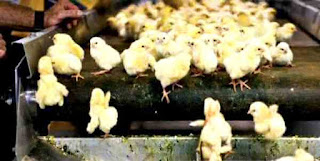New technology automates sexing of chicks.
Fattening up male chicks is a waste of resources. Furthermore, having to manually check the sex of chicks that are sold to producers is a costly burden. There must be an easier way. In Europe a way of determining the sex of chicks while still in the egg will revolutionize the industry.
Female chickens fatten up much quicker than males. Moreover, males do not lay eggs. It may be possible to on-sale the "rejected" eggs for production of egg powder. The new system is 95 per cent effective after the ninth day of gestation.
The way male chicks are disposed of at present is not pretty: they are crushed alive by an industrial crusher. At first, Wouter Bruins of the Netherlands had the aim of ending this mass euthanizing. Now it is seen as a potential extremely profitable enterprise. Sexing can be done at the rate of 4,500 an hour.
◆ Technology by Ty Buchanan ◆
●
. . . . . . . . . . . . . . . . . . . . . . . . . . . . . . . . . .
NEW TECHNOLOGY SELECTS SEX OF CHICKS
NEW TECHNOLOGY SELECTS SEX OF CHICKS
industry, eggs, netherlands, new, technology, cost, revolutionize,
articles news politics economics society anthropology historiography history sociology people nations country asia europe africa u.s. south america central Mediterranean eastern western interesting amusing technology free news sex
articles news politics economics society anthropology historiography history sociology people nations country asia europe africa u.s. south america central Mediterranean eastern western interesting amusing technology free news sex




